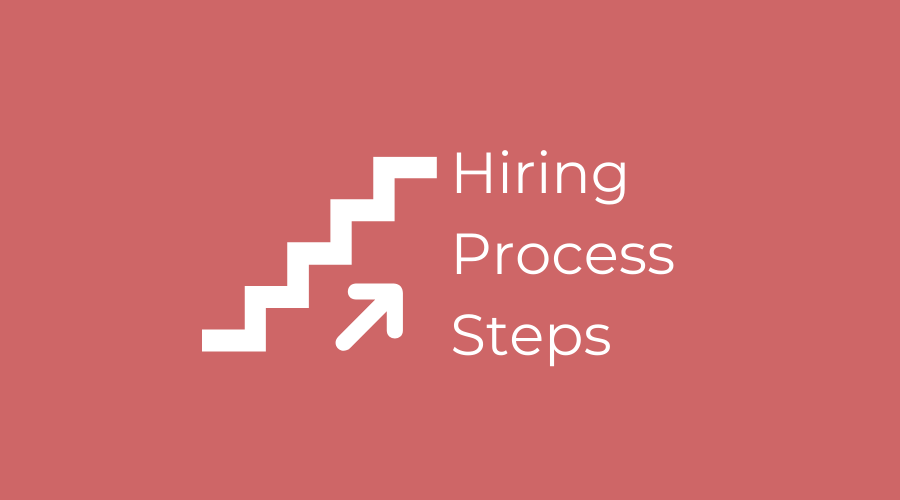The hiring process is comprised of many steps for bringing a new employee into your company. Employers identify a need, recruits from a pool of talent and eventually hires the candidate to fill the role based perviously determined qualifications. Most companies follow the same process but all have certain variables added to thehirinqg mix that vary widely based on culture and types of jobs. Below are the most common steps in today’s hiring process.
Hiring Process, Step by Step
Identify Your Need
Hiring starts with identifying a role that needs to be added. Usually a hiring manager will tell his HR team that he needs to add staff to fill a need in their department. It could be a newly created job or one that has to be backfilled after a person leaves.
Job Description
A job description should be generated that is unbiased and speaks to the candidate. It should contain job requirements, how you qualify, salary/benefits and even reason(s) for why a prospective candidate should apply.
Start Recruiting
Recruitment starts with announcing the new opportunity both internally and externally. But before you begin that figure out where you are going to publicize the role, how you will screen potential candidates, what the interview process will be like and who will conduct the interviews.
Advertise the Job
Begin by posting the job to your applicant tracking system.Promoting the new job opening should start by informing your existing employees. They may be able to refer a friend or colleague to the position thus helping you generate candidates quickly. At most companies referrals are a major way (40% or more) people get recruited. Next, advertise the job on national and/or niche job boards to attract active job seekers. Post the job link to your companies social media channels as well to help spread the word. Job promotion will be important especially in tight job markets where good candidates are at a premium.
Source Candidates
If you have an internal recruiting team, sourcing candidates proactively should also begin. This type of practice recruitment ensures you are targeting good quality candidates who are already employed but might be the perfect fit for your role. Leverage sites like LinkedIn social media and external resume databases to find this talent.
Review Applicants
Companies receive applications mainly two ways, by email or through an applicant tracking system. At this point its up to your recruiters to review each resume and reject or move to the next stage. Some ATS platforms also will rank or score resumes according to criteria you set which is helpful when having to review a high number of applications.
Screening Process
Most interviews usually will begin with a phone screen (with recruiter or HR) although nowadays a video cover letter might be included in the process. These phone screens last around 20-30 mins and are used to determine if the candidate meets the minimum qualifications and is actually interested in the role. These quick interviews are used to narrow down the list of candidates for the next stage.
Formal Interviews
Each company has a different interview cadence but generally interviews are comprised of the following;
- One on ones with the hiring manager that usually focus on the candidates experience, skills, work history and fit for the role
- Follow ups for group interviews (or within a team) that take place in person or in a virtual interview setting.
- Technical interviews for candidates who may need to take coding tests or whiteboard complex problems.
- Final round with leadership so they can sign off on the new hire or go more in-depth on a particular topic to validate their expertise.
Assessment tests may also be given after interviews to help gauge a candidates proficiency with certain software or other complex skill.
The key to interviewing in today’s environment is to keep the total number of interviews to a minimum to ensure a smooth candidate experience.
The Background Check
For many roles expecicially ones that work with money or sensitive data, a background will need to be done to check if a candidate has any kind of major red flag in his/her background. Some employers may go a step farther and review any public accounts found on sites like Facebook and twitter. They are looking to ensure this person would represent the company in a professional manner. Dry screens may also be required at this step.
Decision Time
After whilltling down your final list of candidates to 3 to 5 people and vetting them, it’s time to make your decision on who to hire. Your team should also have a backup candidate identified in case your first choice turns down the job. Acceptance rates are usually high at this stage but it pays to be prepared for the unexpected.
Check References
Reference checks help verify any pertinent information shared by the candidate about previous employment. Questions like ‘would you rehire this person’ or ‘what do they need to work on’ are great for generating valuable feedback on your candidate.
Make the Offer
Once you’ve decided on a candidate it’s time to give them the good news and prep your offer letter. The letter must include the following information;
- Job title
- Start date
- Starting salary
- Location (or remote)
- Benefits and vacation time.
- Any other terms and conditions of the role.
Your candidate may wish to negotiate the salary so be prepared to adjust the offer letter based upon those conversations.
Onboarding
After your candidate accepts its a matter of process of filling out paperwork related to their employment. You’ll need documents like:
- Form W4
- I-9 form and E-Verify
- Tax Withholding and Registrations
- Copy of drivers license
- Employee handbook
- NDA
Once the paperwork is finalized your onboarding can begin in earnest. Some employers do a better job at onboarding than others. You’ll need to make your new hire feel welcome by properly introducing them to your team, setting them with a computer, training if applicable, passwords and whatever else they need to be successful. You may even want to assign them a buddy or mentor to help guide them in their first 33/60/90 days of employment.


